2013 VOLKSWAGEN TOUAREG battery
[x] Cancel search: batteryPage 363 of 440

Driving
situations Requirements and conditions Vehicle behavior
– CAReful use of E-MODE button
⇒ fig. 251.
The high-voltage battery discharges quickly
with the E-MODE button switched on. This
can increase fuel consumption since driving
in electric mode is preferred in this case,
even though the combustion engine would
be more efficient.
Driving on
country roads
and highways.
– Conscious easing off of the
accelerator, to enable longer sailing
distance.
By easing off the accelerator, the
combustion engine is automatically
switched off and de-clutched. The vehicle
glides without engine power.
- Reducing speed by easing off the
accelerator early and not by
braking.
Sailing possible. Reduction of speed this
way is more fuel-efficient than through
braking.
- Avoid speeds of over about 160
km/h (99 mph).
Efficient sailing is possible with a speed of
about 160 km/h (99 mph) .
- CAReful selection of gear (S).
Sporty driving style with activated sport
programme increases fuel consumption.
Efficient sailing in sport programme with
combustion engine automatically switched
off is possible with a speed of about 70
km/h (43 mph).
Driving in cold
months.
- Do not warm up the combustion
engine by running it with the
vehicle stationary.
The temperature of the combustion engine
increases very slowly, but fuel consumption
increases considerably.
– CAReful use of heating for
windshield and the rear window,
outside mirror, seat and steering
wheel.
This prevents energy from being lost and
saves energy for the electric motor.
- Never leave the vehicle in a
garage over night.
This prevents the high-voltage battery and
the vehicle interior from cooling down too
much. The optimal temperature of the high-
voltage battery is reached quicker at the
beginning of the journey and the
combustion engine can be switched off
quicker when the vehicle interior is
sufficiently heated.
Page 365 of 440

Use the following indicators to tell when the vehicle is being powered electrically:
�x Tachometer for the combustion engine shows zero engine revolutions.
�x Instrument cluster display.
�x Infotainment System screen.
Extended electro-mode drive (E-Mode)
By pressing the E-MODE button ⇒ fig. 251, the driver can extend the normal limits of electrical motor
drive so that the electric motor powers the vehicle whenever possible (given the battery charge level
and the way you are driving). In this mode, the vehicle is propelled by the electric motor as much as
possible.
Extended electro-mode drive can be activated only if all of the following conditions apply:
�x The high-voltage battery must have an adequate charge.
�x The driver must accelerate gently.
�x The speed must be low.
If extended electro-mode drive is not possible, a message appears in the instrument cluster display.
Die activation of the extended electro-mode drive will be indicated by the symbol �%�
Page 366 of 440
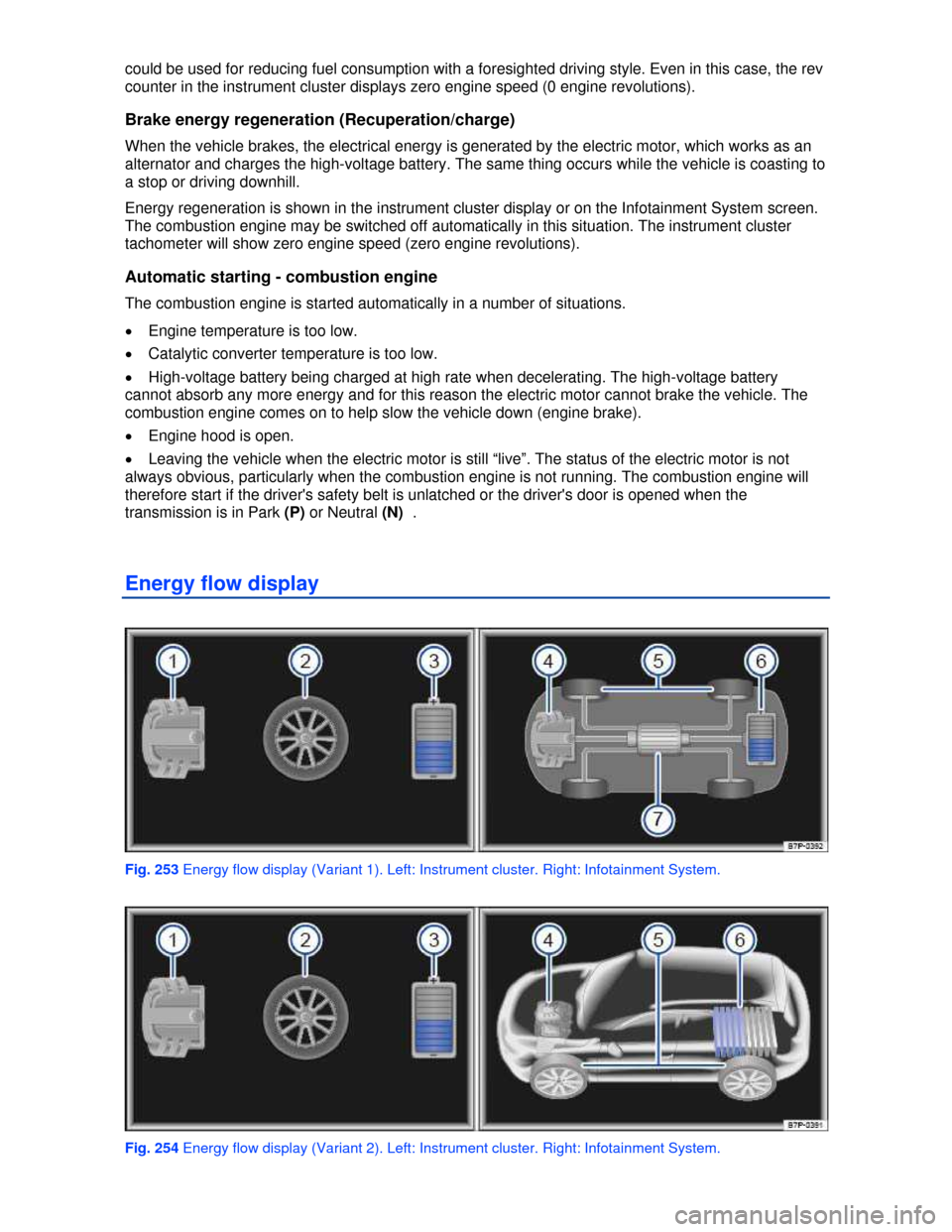
could be used for reducing fuel consumption with a foresighted driving style. Even in this case, the rev
counter in the instrument cluster displays zero engine speed (0 engine revolutions).
Brake energy regeneration (Recuperation/charge)
When the vehicle brakes, the electrical energy is generated by the electric motor, which works as an
alternator and charges the high-voltage battery. The same thing occurs while the vehicle is coasting to
a stop or driving downhill.
Energy regeneration is shown in the instrument cluster display or on the Infotainment System screen.
The combustion engine may be switched off automatically in this situation. The instrument cluster
tachometer will show zero engine speed (zero engine revolutions).
Automatic starting - combustion engine
The combustion engine is started automatically in a number of situations.
�x Engine temperature is too low.
�x Catalytic converter temperature is too low.
�x High-voltage battery being charged at high rate when decelerating. The high-voltage battery
cannot absorb any more energy and for this reason the electric motor cannot brake the vehicle. The
combustion engine comes on to help slow the vehicle down (engine brake).
�x Engine hood is open.
�x Leaving the vehicle when the electric motor is still “live”. The status of the electric motor is not
always obvious, particularly when the combustion engine is not running. The combustion engine will
therefore start if the driver's safety belt is unlatched or the driver's door is opened when the
transmission is in Park (P) or Neutral (N) .
Energy flow display
Fig. 253 Energy flow display (Variant 1). Left: Instrument cluster. Right: Infotainment System.
Fig. 254 Energy flow display (Variant 2). Left: Instrument cluster. Right: Infotainment System.
Page 368 of 440
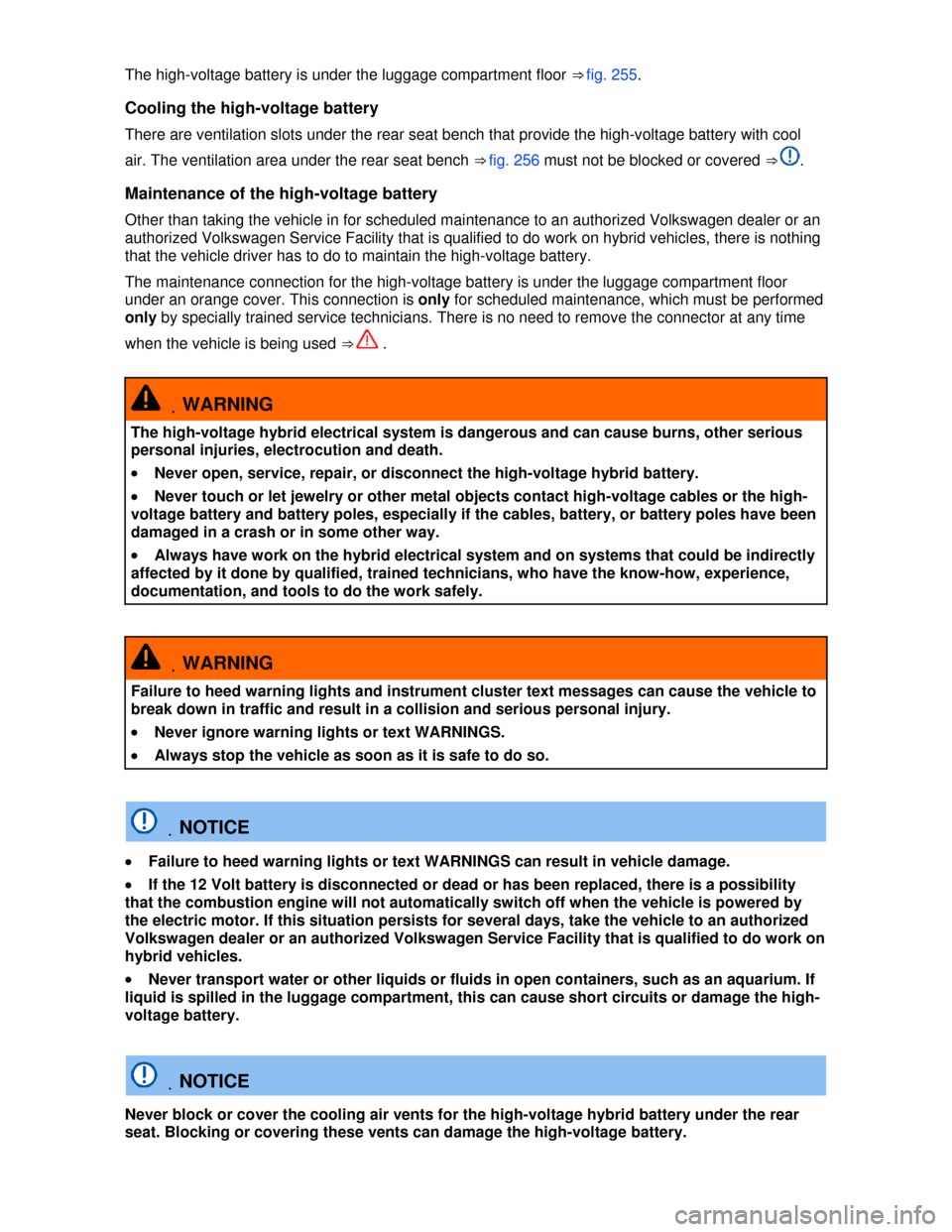
The high-voltage battery is under the luggage compartment floor ⇒ fig. 255.
Cooling the high-voltage battery
There are ventilation slots under the rear seat bench that provide the high-voltage battery with cool
air. The ventilation area under the rear seat bench ⇒ fig. 256 must not be blocked or covered ⇒ .
Maintenance of the high-voltage battery
Other than taking the vehicle in for scheduled maintenance to an authorized Volkswagen dealer or an
authorized Volkswagen Service Facility that is qualified to do work on hybrid vehicles, there is nothing
that the vehicle driver has to do to maintain the high-voltage battery.
The maintenance connection for the high-voltage battery is under the luggage compartment floor
under an orange cover. This connection is only for scheduled maintenance, which must be performed
only by specially trained service technicians. There is no need to remove the connector at any time
when the vehicle is being used ⇒ .
.WARNING
The high-voltage hybrid electrical system is dangerous and can cause burns, other serious
personal injuries, electrocution and death.
�x Never open, service, repair, or disconnect the high-voltage hybrid battery.
�x Never touch or let jewelry or other metal objects contact high-voltage cables or the high-
voltage battery and battery poles, especially if the cables, battery, or battery poles have been
damaged in a crash or in some other way.
�x Always have work on the hybrid electrical system and on systems that could be indirectly
affected by it done by qualified, trained technicians, who have the know-how, experience,
documentation, and tools to do the work safely.
.WARNING
Failure to heed warning lights and instrument cluster text messages can cause the vehicle to
break down in traffic and result in a collision and serious personal injury.
�x Never ignore warning lights or text WARNINGS.
�x Always stop the vehicle as soon as it is safe to do so.
.NOTICE
�x Failure to heed warning lights or text WARNINGS can result in vehicle damage.
�x If the 12 Volt battery is disconnected or dead or has been replaced, there is a possibility
that the combustion engine will not automatically switch off when the vehicle is powered by
the electric motor. If this situation persists for several days, take the vehicle to an authorized
Volkswagen dealer or an authorized Volkswagen Service Facility that is qualified to do work on
hybrid vehicles.
�x Never transport water or other liquids or fluids in open containers, such as an aquarium. If
liquid is spilled in the luggage compartment, this can cause short circuits or damage the high-
voltage battery.
.NOTICE
Never block or cover the cooling air vents for the high-voltage hybrid battery under the rear
seat. Blocking or covering these vents can damage the high-voltage battery.
Page 369 of 440
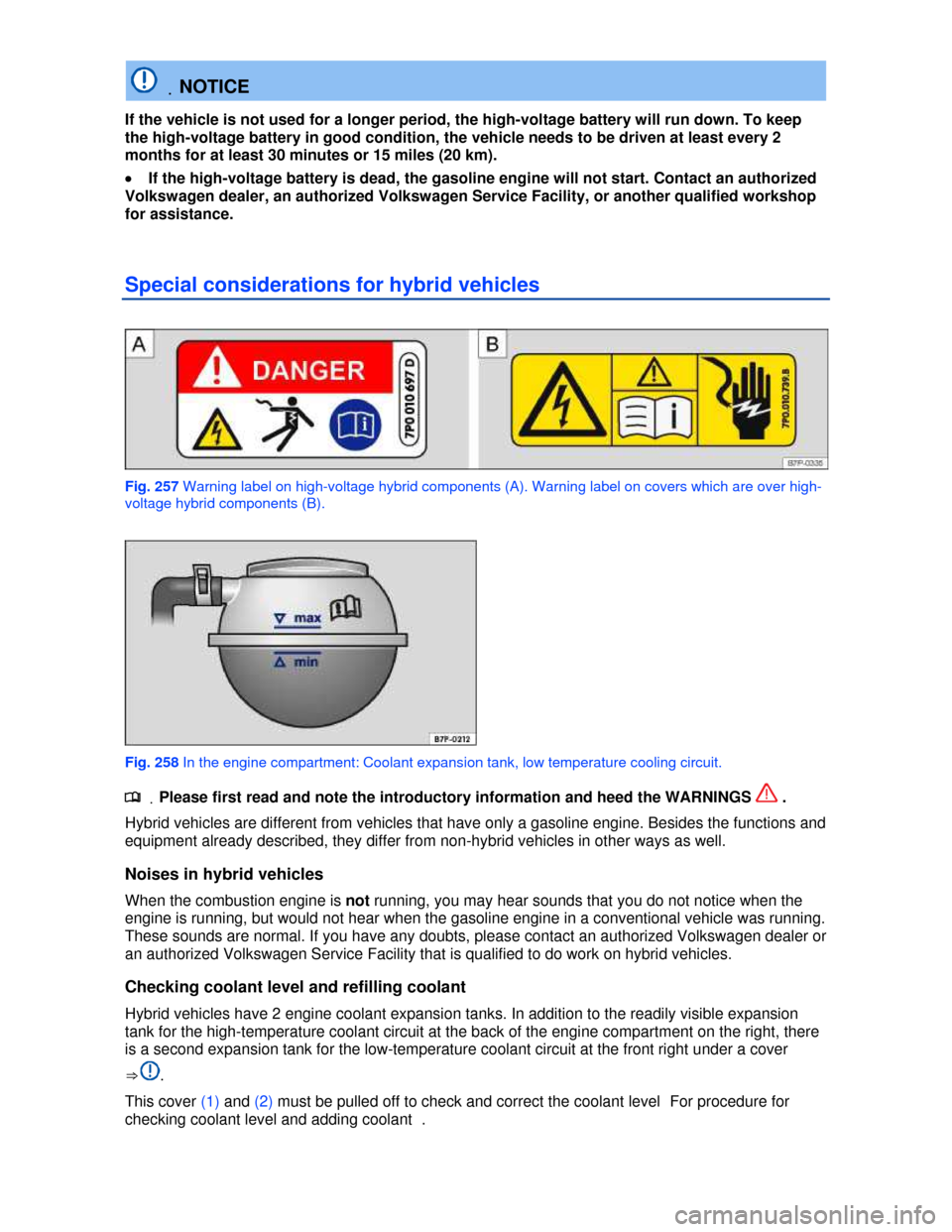
.NOTICE
If the vehicle is not used for a longer period, the high-voltage battery will run down. To keep
the high-voltage battery in good condition, the vehicle needs to be driven at least every 2
months for at least 30 minutes or 15 miles (20 km).
�x If the high-voltage battery is dead, the gasoline engine will not start. Contact an authorized
Volkswagen dealer, an authorized Volkswagen Service Facility, or another qualified workshop
for assistance.
Special considerations for hybrid vehicles
Fig. 257 Warning label on high-voltage hybrid components (A). Warning label on covers which are over high-
voltage hybrid components (B).
Fig. 258 In the engine compartment: Coolant expansion tank, low temperature cooling circuit.
.�
Page 370 of 440
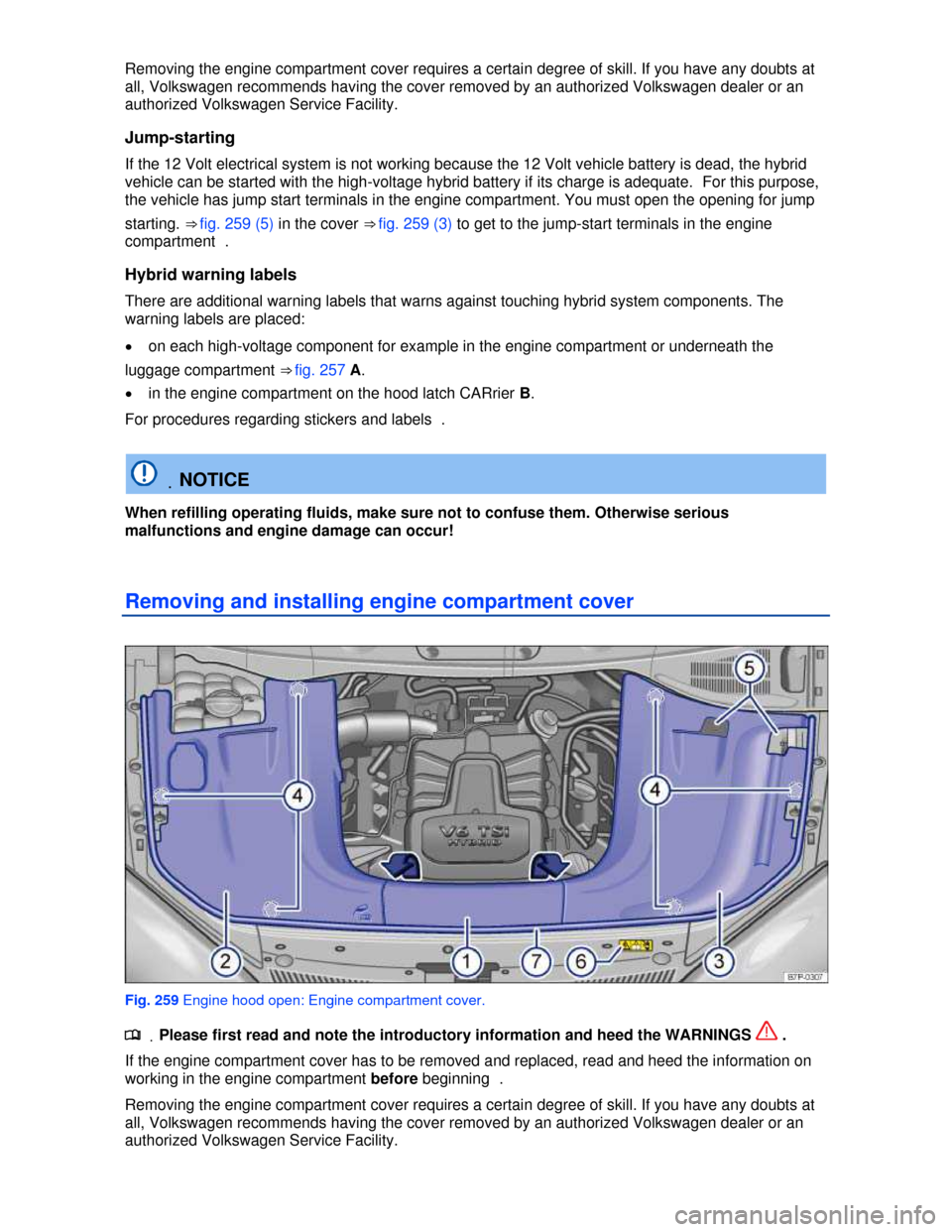
Removing the engine compartment cover requires a certain degree of skill. If you have any doubts at
all, Volkswagen recommends having the cover removed by an authorized Volkswagen dealer or an
authorized Volkswagen Service Facility.
Jump-starting
If the 12 Volt electrical system is not working because the 12 Volt vehicle battery is dead, the hybrid
vehicle can be started with the high-voltage hybrid battery if its charge is adequate. For this purpose,
the vehicle has jump start terminals in the engine compartment. You must open the opening for jump
starting. ⇒ fig. 259 (5) in the cover ⇒ fig. 259 (3) to get to the jump-start terminals in the engine
compartment .
Hybrid warning labels
There are additional warning labels that warns against touching hybrid system components. The
warning labels are placed:
�x on each high-voltage component for example in the engine compartment or underneath the
luggage compartment ⇒ fig. 257 A.
�x in the engine compartment on the hood latch CARrier B.
For procedures regarding stickers and labels .
.NOTICE
When refilling operating fluids, make sure not to confuse them. Otherwise serious
malfunctions and engine damage can occur!
Removing and installing engine compartment cover
Fig. 259 Engine hood open: Engine compartment cover.
.�
Page 394 of 440
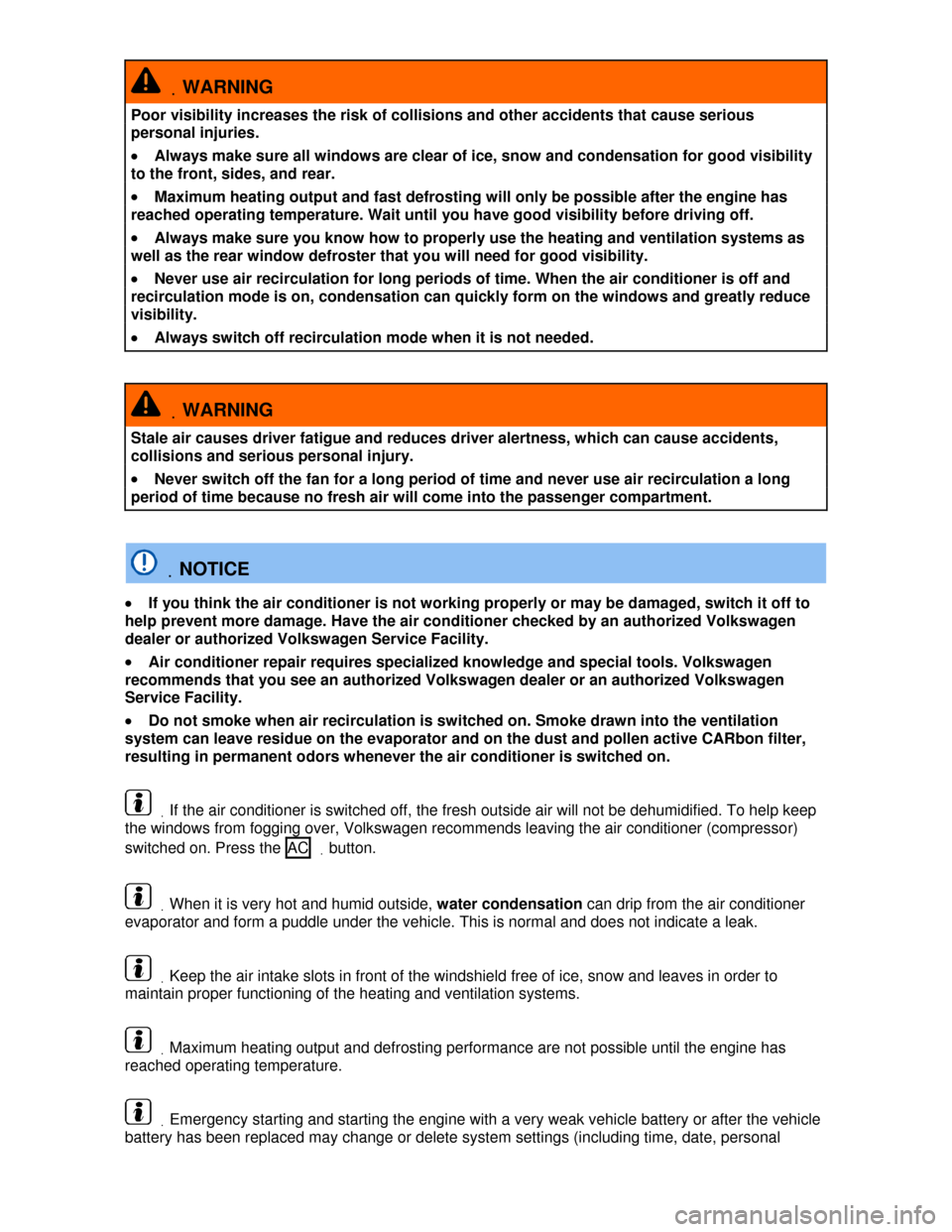
.WARNING
Poor visibility increases the risk of collisions and other accidents that cause serious
personal injuries.
�x Always make sure all windows are clear of ice, snow and condensation for good visibility
to the front, sides, and rear.
�x Maximum heating output and fast defrosting will only be possible after the engine has
reached operating temperature. Wait until you have good visibility before driving off.
�x Always make sure you know how to properly use the heating and ventilation systems as
well as the rear window defroster that you will need for good visibility.
�x Never use air recirculation for long periods of time. When the air conditioner is off and
recirculation mode is on, condensation can quickly form on the windows and greatly reduce
visibility.
�x Always switch off recirculation mode when it is not needed.
.WARNING
Stale air causes driver fatigue and reduces driver alertness, which can cause accidents,
collisions and serious personal injury.
�x Never switch off the fan for a long period of time and never use air recirculation a long
period of time because no fresh air will come into the passenger compartment.
.NOTICE
�x If you think the air conditioner is not working properly or may be damaged, switch it off to
help prevent more damage. Have the air conditioner checked by an authorized Volkswagen
dealer or authorized Volkswagen Service Facility.
�x Air conditioner repair requires specialized knowledge and special tools. Volkswagen
recommends that you see an authorized Volkswagen dealer or an authorized Volkswagen
Service Facility.
�x Do not smoke when air recirculation is switched on. Smoke drawn into the ventilation
system can leave residue on the evaporator and on the dust and pollen active CARbon filter,
resulting in permanent odors whenever the air conditioner is switched on.
.If the air conditioner is switched off, the fresh outside air will not be dehumidified. To help keep
the windows from fogging over, Volkswagen recommends leaving the air conditioner (compressor)
switched on. Press the AC .button.
.When it is very hot and humid outside, water condensation can drip from the air conditioner
evaporator and form a puddle under the vehicle. This is normal and does not indicate a leak.
.Keep the air intake slots in front of the windshield free of ice, snow and leaves in order to
maintain proper functioning of the heating and ventilation systems.
.Maximum heating output and defrosting performance are not possible until the engine has
reached operating temperature.
.Emergency starting and starting the engine with a very weak vehicle battery or after the vehicle
battery has been replaced may change or delete system settings (including time, date, personal
Page 395 of 440
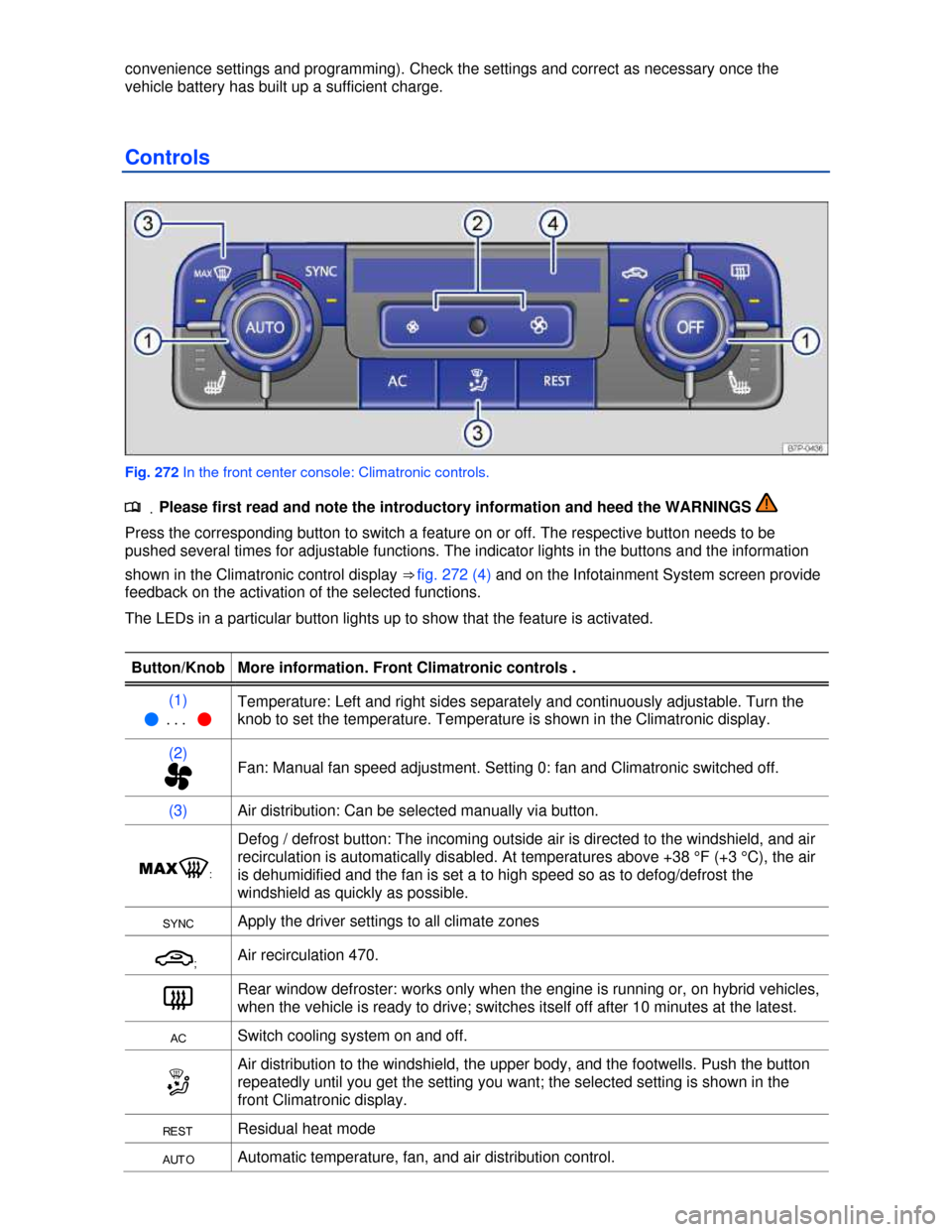
convenience settings and programming). Check the settings and correct as necessary once the
vehicle battery has built up a sufficient charge.
Controls
Fig. 272 In the front center console: Climatronic controls.
.�